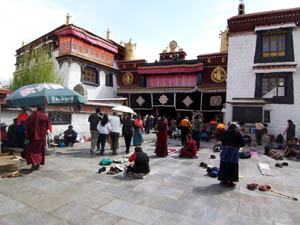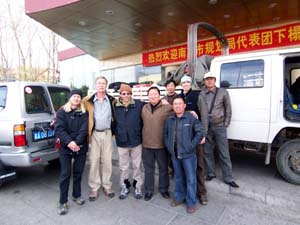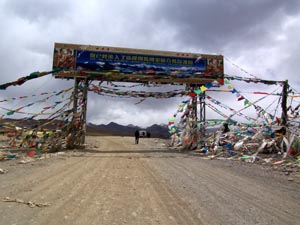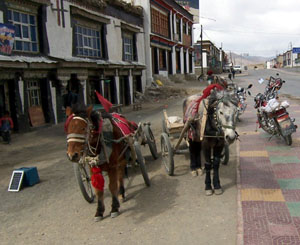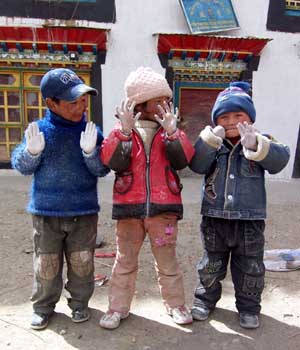|
CHO
OYU 2006 ~ EVEREST 2004 A Team of International Friends Helping Amputees Change the World |
|||||
|
Home
|
Press
| Team | Our Story
| Goals | Journal
| Everest Success | What's
Next? | Our Mission | Friends
| Sponsors | Contact
us | Contribute
| Search
|
|||||
Expedition Journal ~ Overland"Clip
in" and follow along with our
|
|||||
| Special thanks to our sponsor I-LINX of Washington, DC for their generous communication logistics support of our expedition. |
Updated by Linda McMillan
Wednesday, April 5,
2006
Buying supplies in Lhasa
Today we tested our blood oxygen levels with a tiny device that George wisely brought. It clips to a finger and within a few seconds shows your pulse and blood oxygen level. A pulse in the 80s is good and blood oxygen in the 90s is good. We noticed our pulse rates shot up after eating (as the case in the image at right). Everyone but Linda was fine; her blood oxygen level was low so she started taking Diamox to bring the level up. We spent the day with our Tibetan guide purchasing items needed for the expedition that we could not bring from the US: tsampa (ground barley used for food and ceremonial purposes by the Sherpas and Tibetans), canned foods, fresh fruit, dried fruit, etc..
We
also walked around the Jokhang, which is Tibet's most sacred temple.
Tibetans stream around the temple all day, some prostrating themselves
as they pray, It is a beautiful temple and plaza whose sacred nature
is very evident. It is also in the center of town, surrounded with
stalls, shops, and small restaurants. Our time in Lhasa is short
today, but we will have two days to explore the city more fully
after the expedition.
Thursday, April 6,
2006
Drive from Lhasa to Shigatse
Today we loaded up our gear into our two vehicles:
- a sturdy Land Cruiser, driven skillfully by a Tibetan driver, for our team members plus gear for three days of overland travel
- a not-so-sturdy
flat-bed truck with a faulty battery, driven by a local driver,
carrying our Xinjiang (western China) cook and cook assistant
(neither of them speak English), plus all the rest of our expedition
gear.
We said our goodbyes to Guo Jin Wei and headed off down a very good paved highway toward our destination that day, Shigatse. It is the second-largest town in Tibet and has a huge monastery which is being restored. The terrain was stunning, as we drove along a broad river valley with braided courses, perfect for animals and migratory birds like the large Black-Necked cranes shown at right. We arrived in the afternoon at Shigatse, and checked into a comfortable hotel that looked to be a former military compound. It had nice rooms and a large quadrangle area for the vehicles which was secured at night.
Friday, April 7, 2006
Drive from Shigatse to Tingri
The next day we loaded up again after breakfast and headed off to the junction town of Tingri, where we will meet up with our Sherpa team members who drove over Zhangmu Pass from Nepal by Land Cruiser. The pavement ended not long after we left Shigatse, and the road became gradually rougher, narrower, and more twisted. Driving protocol required sounding the car's horn when entering one of what seemed like hundreds of blind curves. This system seemed adequate until we entered one innocuous blind curve without sounding the horn. We were suddenly faced with a flatbed truck heading straight for us. Brakes were slammed on both vehicles, but on the dirt and gravel surface the bed of the truck swiveled and continued straight for our vehicle. If struck, we would have been swatted right off the road and over the 200 ft cliff to the river below. The seconds ticked by agonizingly slowly as we watched the truck bed slide towards us then finally stop about 5 ft. from our Land Cruiser. Many seconds later, both drivers proceeded very slowly, and all was set straight again.
About a hour later we stopped at a high alpine pass area to eat our delicious box lunches from the hotel in Shigatse. Life was good! From there, we crested the Gyatso La (Pass) marked with a large entrance gate and prayer flags. This is where we had our first views of Qomolungma (Mount Everest) and Cho Oyu, festooned with cloud banners streaming from their summits. Obviously very windy on the high peaks today. We passed through the Qomolungma Nature Preserve, which keeps this area unspoiled and wild.
From the high and wild scenery we descended into the scrappy little town of Xegar, where we waited for the problematic truck carrying our expedition gear. This tough, strategic little highway town with an important military checkpoint and army base clearly showed the stark contrasts that increased trade and tourism were bringing to this region. Tibetans, like their Sherpa cousins in Nepal, seem quite comfortable straddling huge technological divides. They seem to readily understand and embrace changes that help to improve their lives (like the solar panel and motorcycle), yet they don't completely abandon old technologies or ways if those actually prove more reliable and cheaper (like the patient tiny horses that run on dry grass and the eclectic array of easy-to-fix homemade carts they pull).
Our wait for the problematic truck was long, about 2-1/2 hours, since they had to change a tire somewhere along the way and get it patched up. The long and terrible rocky roads in Tibet make a tire's life very tortured and brief. We realized that this explained why in each city and town we passed through in Tibet, at least 30% of the shops sold tires or tire repair services. There is a steady stream of customers for them now, and this is sure to grow in the future with more goods and people flowing through the region
While we waited impatiently in Xegar for the problematic truck, some of the local teens walking home from school spotted us and aggressively asked for money from us. Not to be deterred by the closed doors of our vehicle, the girls and boys started opening them to further press their demands. After we locked the doors they eventually left. A few minutes later, a group of three cute little boys approached asking for candy. Not deterred when we told them we did not have any candy, the tiny, spunky boys (about 3 or 4 years old) immediately won us over by displaying a much higher level of panhandling creativity than their teenage neighbors. They quickly ran over to the whitewashed walls of their homes, rubbed their little hands on the chalky white dust, and did a hilarious series of dances for us, highlighted with various displays of their little white hands. We laughed long and hard at their cleverness, and rewarded their performance with some of the crackers and delicious apples we brought from Lhasa.
The problematic truck finally arrived and took on more fuel at the huge gas station on the main street. Actually, most of the gas stations we passed on this rough highway were outlandishly huge, new, and almost always completely devoid of customers. Evidently the Chinese are planning for a big future, building gargantuan stations that will be able to refuel dozens of vehicles at once. For now, however, the cavernous stations just seem eerie.
After clearing the military checkpoint outside Xegar, we drove a few hours more to our next stop in the town of Tingri. There we checked into the typically Tibetan Snow Leopard Hotel, tired and hungry, where we were greeted warmly by our Sherpa team member Ang Dawa. The Sherpas are staying at a hotel nearby (the Everest View Lodge), and will meet us for breakfast tomorrow.
[ahead to next Journal section]
[back to Journal home page]

